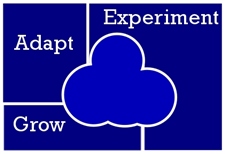Technology has had a renaissance over the past few years, and it now seems that we are at a tipping point where the implications of technical advancements are no longer limited to a few new product features or the CIO’s staff meetings. Instead, mature businesses are transforming into completely new entities in a few years time. Products are becoming intelligent and aware, hopefully signaling an upcoming surge in productivity. Most importantly, it seems like change in many industries is accelerating at an exponential pace, one that might share a deep link to Moore’s law.
After spending time with over a hundred CTOs since joining Dell OEM Solutions as a technologist, it’s become clear that there are three sweeping trends — cloud, big data, and mobility — that are rooted in IT but biggest impact will be for OEMs of other products and services, many of which have IT at their core.

Much has been written about these trends from a CIO’s perspective. Now it’s time to talk about what these mean for the CTO and product team of every Dell OEM Solutions customer.
In this blog post, I’ll demonstrate why cloud is so much bigger than a traditional IT discussion. Two posts will follow that give the same attention to big data and mobility.
Three ways cloud is about the top-line rather than boring CAPEX vs. OPEX discussions:
1. Cloud unbridles customer growth
When Netflix wanted to create a streaming business that would replace their DVD shipping operation, they turned to the cloud, because there was no other option. Netflix knew they could only stand up a new datacenter every six months, and this schedule would not match their growth projections of streaming customers. The only way to accommodate their customer demand was by turning to the cloud.
2. Cloud enables rapid product enhancements
National Instruments (NI), created a monitoring system for wind turbines. Instead of going with a completely embedded solution, in which all the specialized hardware and software residing in each windmill, NI thinned out the embedded components and pushed a substantial portion of the product into the cloud. The refresh cycle for embedded products is typically anywhere from three to thirty years, while the refresh cycle for a SaaS product can be minutes. Imagine being the NI sales team, knowing that you can adjust your product in a few weeks to match any RFP you can find and also knowing that your competitors can’t possibly add features that fast to their traditional embedded solutions.
3. Cloud enables experimentation, as a business
Why do so many startups turn to the cloud rather than buying their own hosting infrastructure? Startups are still learning about their customers by trying high risk product ideas. These companies are still learning about their customers, and they need to do it as inexpensively as possible.
A Fortune 50 company already has lots of customers, engineers and operations staff for its existing products, and this large infrastructure is too much overhead for small experimental products. By embracing a cloud strategy, this company could pilot nascent product ideas for new markets that would normally be crushed by any decent marketing strategist overseeing a mature product portfolio.
Hold on, cloud can do all of this?
That’s like saying a rifle can hit its prey without a trained hunter at the ready. Unfortunately, cloud cannot do everything listed above on its own, but it is a great way to enableeverything listed above. There is a critical missing piece: an agile culture.
An agile culture, by definition, is one designed to move quickly. Once you’ve figured out how to move quickly as an organization, you want the right technology to start speeding up the pace. Normally, when Agile is discussed, it’s as a software development methodology. In this context, I’m talking about the entire organization under the CEO, not just the CIO or VP of Engineering.
Once you’ve launched your new SaaS product, the sales team must be ready to start selling it to all of your customers on launch day. Existing customers must be kept aware of frequent product changes and have some way to easily provide feedback into your development activities. Interestingly enough, many cloud based tools have popped up for just these purposes.
What if you don’t want to speed up the pace? Then get ready to suffer the consequences. In every industry, once a single competitor moves to a culture and toolset that enables great product ideas to be tested quickly, fine-tuned immediately, and grown without bounds, other competitors have little choice but to follow suit.
Hopefully this explains why cloud and an agile culture are the foundation of the companies which will dominate the next decade, and should not be limited to purely IT discussions.
You can follow @JoshNeland on Twitter or the Dell OEM Solutions team @DellOEM on Twitter as well.